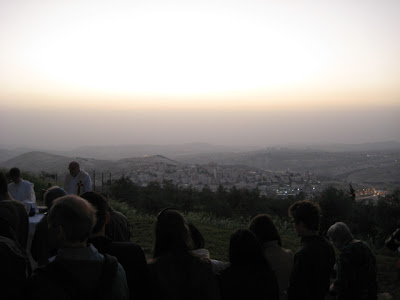In an effort to enjoy the lovely Spring weather in Palestine and also to explore the natural areas surrounding Bethlehem, my fiance and I have gone on several hikes in the past month or two. One of the delightful surprises for me on these trips was the discovery of natural springs in the villages surrounding Bethlehem. These trips, however, also carried with them the realization of the intricacies of the injustices of the Israeli occupation of the West Bank, especially in the issue of water collection and distribution.
After hiking through Wadi (Valley) Makhrour, we ended our hike in the village of Battir. At the center of this village is a natural spring. After a long hike, we were able to fill our bottles and enjoy the fresh taste of natural spring water.
After hiking through Wadi (Valley) Makhrour, we ended our hike in the village of Battir. At the center of this village is a natural spring. After a long hike, we were able to fill our bottles and enjoy the fresh taste of natural spring water.
On another hike, we stopped in the middle for a rest near a natural spring just down the hill from the village of al-Walaja. This spring flows from a waterfall and eventually fills a pool with its clear, pure water.
On the one hand, we enjoyed these natural wonders, while on the other hand being confronted with the injustices of Israeli occupation. Although Battir's spring is overflowing, Palestinians are not allowed to build any structures in order to collect this water. Instead, the must allow it to flow to the valley, to aquifers, from which the Israeli authorities will collect this water, and then sell it back to Palestinians for expensive prices. The same goes for the spring that lies just outside the village of al-Walaja. Near this spring, two water pumps are found, which pump the water from the spring. The towers of Mekorot, the Israeli water company, which collects this water and subsequently sells it to both Israelis and Palestinians, can be seen from this hike in the nearby settlement of Gilo.
 |
| Battir's spring is overflowing with water after this year's abundant amount of rain. |
The Oslo Agreements left several "core issues" to be settled in any final status agreements. These issues include Jerusalem, security, refugees, borders, water and settlements; issues that have yet to be settled to this day. In an attempt to address the issue of water, the Oslo Agreements set up the Joint Water Committee (JWC) within which Palestinians and Israelis were to work together on the issue of water. Not only does the JWC give Israel veto power to any plans to build structures to collect water, the JWC has not been effective in managing water resources. Until the Second Intifada, the JWC met frequently, up to 10 times per year. According to a 2009 World Bank report, since 2002 the frequency with which the JWC met dropped to up to 3 times per year, with only one meeting in 2008. Clearly, with the lack of meetings of the JWC in the past 10 years, Israelis and Palestinians are not effectively cooperating in the distribution of water.
 |
| Al-walaja's spring. |
As a result of any lack of discussion on the issues of water, the Israeli occupation controls most Palestinian water sources. With the addition of the building of the separation barrier, 194 Palestinian wells and 85 Palestinian springs are cut off from use by Palestinians. Even the spring in al-Walaja is currently being cut off from this community by the rapidly building of the separation barrier. Not only will the water be controlled and taken by the Israeli authorities, but this area will not longer be a place for picnics and family outings as we witnessed on the day we were there.
Moreover, the use of water between Israelis and Palestinians is drastically imbalanced. The average Israeli uses 4 to 5 times more water than that of the average Palestinian. A 2011 B'tselem report showed that the use of water in Israeli settlements compared with nearby Palestinian villages was approximately 400 l/c/d (litres/capita/day) to 20 or 80 l/c/d (depending on the village). In some places, that is 8 to 9 times the use of water. Furthermore, the Israeli company of Mekorot sells water to settlement farmers at subsidized prices, whereas the average Palestinian household pays between 5% to 40% of their monthly income on water.
 |
| "Nicely" leveled land to make way for the path of the separation barrier. |
ARIJ's (The Applied Research Institute - Jerusalem) for The Status of the Environment in the oPt (occupied Palestinian territories), 2011
Assessment of Restrictions on Palestinian Water Sector Development an April 2009 World Bank Report.
Walking Palestine by Stefan Szepesi







